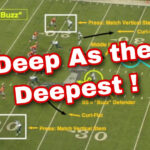By: Chad Wilson – Owner – All Eyes DB Camp
IG: @alleyesdbcamp
Disguising coverage is a critical aspect of defensive strategy, as it can confuse quarterbacks and disrupt offensive plays. As a defensive back, coach or coordinator, here are some effective ways to disguise coverages on defense when you are trying to make things hard on the offense.
Pre-Snap Alignment Variations
This is obviously the most common way to disguise coverages. Train your defensive backs to line up differently pre-snap. For instance, a Cover 2 look might evolve into a Cover 3 after the snap. Vary the alignment of safeties, cornerbacks, and linebackers to keep the offense guessing. This does not stop when the when the quarterback audibles too. The mistake many defenses and secondaries make is disguising their look then staying in that look once the quarterback calls an audible. In the middle of that audible, movement should begin again with signals being called. Those signals may mean something or they may not but al least give the illusion that this audible may have potentially changed the coverage.
Blitz Disguises
Integrate disguised blitz packages into your defensive scheme. Show a potential blitz look pre-snap but drop those players into coverage after the snap. This can create confusion for the offensive line and the quarterback, potentially leading to rushed or inaccurate throws. This is not new but we sure have seen a lot more of it in this 2023 NFL season. Pre-snap movement is great however, a static blitz look that turns into a zone can be problematic for quarterbacks. Forcing the QB to read after he takes the snap will always be better than letting him get a clear picture before he receives the ball.
Rotation of Safeties
Utilize rotations of safeties post-snap. Start with a two-deep safety look and rotate into a single-high safety or vice versa after the snap. This rotation can disrupt the quarterback’s pre-snap read and force him to adjust on the fly. This relates to the previous aspect on blitz disguises. The same way that post snap movement can confuse blocking assignments vs a potential blitz is the same way that post snap movement in the secondary can confuse route assignments and QB reads. Though QBs have gotten better at reading safety rotations to determine coverage, it is still best to make them do it with the rush coming than letting them know what you’re in before the snap.
Cornerback Press Technique
Teach cornerbacks to use press technique, even if the defense is ultimately playing zone coverage. This can give the appearance of man-to-man coverage and disrupt the timing of the receivers’ releases, making it challenging for the quarterback to identify the actual coverage. One of the best things you can learn as a cornerback is proper bail technique. Quarterbacks will often read cornerbacks before the snap to grab clues about the coverage. They are looking to see your cushion and leverage if you are off. They are checking your eyes in press to see if you are truly in man, looking to bail or potentially blitzing. Get good at covering up your true intentions by where you are looking pre-snap.
Zone-to-Man Transition
Train your defenders to smoothly transition from a zone to man-to-man coverage post-snap. This can be particularly effective in confusing quarterbacks who expect a specific coverage but suddenly face a different look. Matchup zone has been one of the best inventions for the defense in this pass happy era. A good mixture of spot drop zones and match-up zones can fool the QB into thinking a window is open when it isn’t. If you are a coordinator, being strictly match-up zone is not as effective as mixing the two as the QB has less of a chance of getting fooled.
Pattern Reading
Teach your defensive backs to read offensive patterns and adjust their positioning based on those patterns. By recognizing common route combinations, defenders can anticipate the quarterback’s decisions and make effective coverage adjustments. A great aspect of match-up zone is reading route combinations. This gives the defensive backs the ability to anticipate routes and make big plays. Often times, one route breaks before another. Reading the break gives strong clues about when the other route in the combination will be.
Communication
Emphasize clear and concise communication among defensive players. Effective communication allows for seamless adjustments and ensures that all players are on the same page, even when disguising coverages. I have clearly emphasized this in other articles on this site. Whether you are playing zone or man, being able to effectively disguise does not happen unless there is communication in the back end. With movement occurring on both offense and defense, remaining silent in the secondary is a surefire way to leave someone wide open. Open your mouth and speak. It’s crucial to your ability to disguise your true intentions.
Create Conflicting Keys
Design defensive schemes that provide conflicting keys for the quarterback. For example, show a cornerback in press coverage while the safety on that side drops deep into zone coverage. This can create hesitation and indecision for the quarterback. Sometimes as a coach you need to be creative. Of course you went to the clinic and took all the notes from the coach on how to run the scheme. However, the recipe may need a little twist on it to suit your tastes. Come up with some looks that betray the the beliefs of the offense. Thinking one thing and having it be another is the mother of sacks and interceptions. Cook up some confusing looks in your scheme. This will require you to know something about how offenses work and what they are reading.
Adapt to Game Situations
Be adaptable based on the flow of the game. If a particular disguise is consistently effective, continue to use it. If the offense adjusts, be ready to switch up your disguises to maintain unpredictability. Consistency and discipline among defensive players are key when implementing disguise strategies. The goal is to create uncertainty for the quarterback while maintaining sound coverage principles within the defense. Another things is don’t use just one way to stop a play. Have two options available. Be ready to alternate between them on series. After the offense has talked about what you are doing and prepared their plot, it’s nice to screw it all up by running something different than what they just plotted against. Stay one step ahead.
In conclusion, against a solid passing attack, you will need more than just skill to get the job done if your opponent has good players. Play chess vs. the offense by incorporating these disguising techniques into your game plan. Not only does it make things harder for the offense to operate, it can be fun for the defense. Who doesn’t like a great game of cat and mouse?
Chad Wilson is the owner of All Eyes DB Camp and author of "101 DB Tips". He played college football at the University of Miami and briefly in the NFL for the Seattle Seahawks. Over his 15 year high school football coaching career, he tutored over a dozen Division I defensive backs and as a trainer has worked with NFL All Pros, first round draft picks, college football All Americans and Top 10 ranked high school football prospects.









